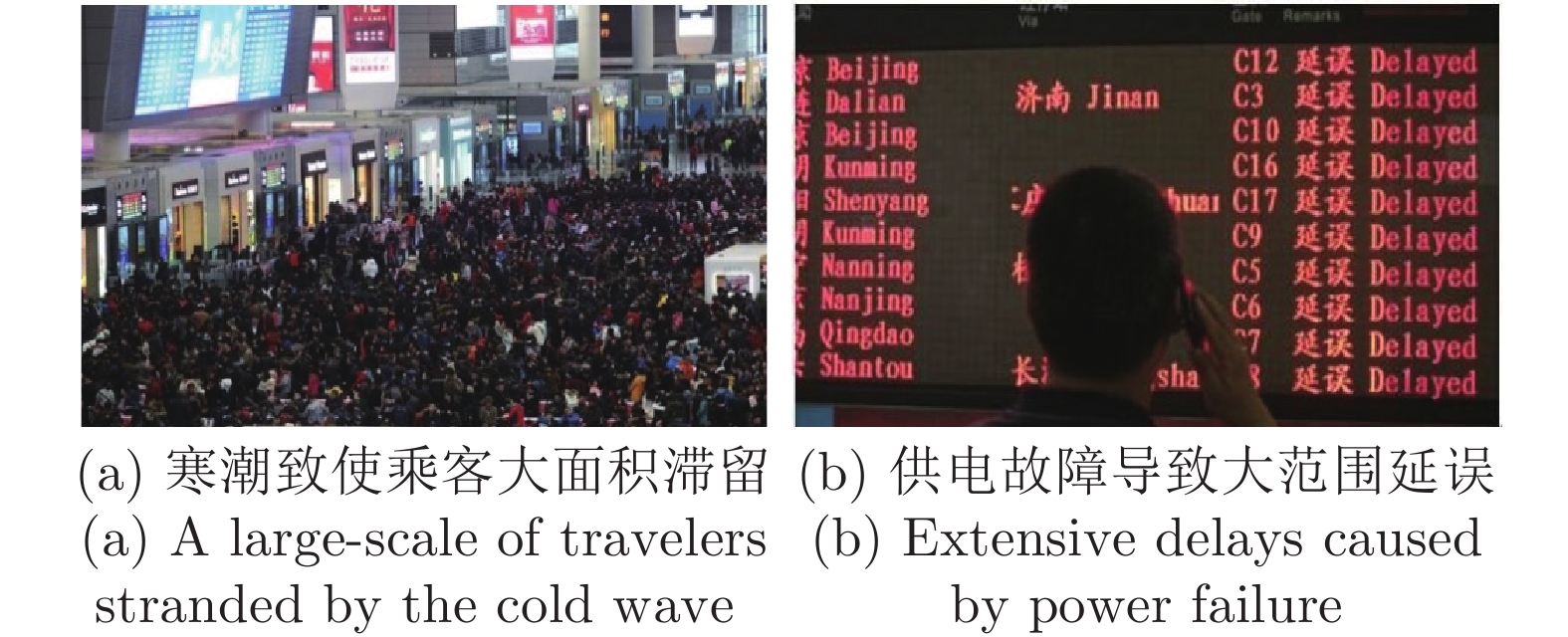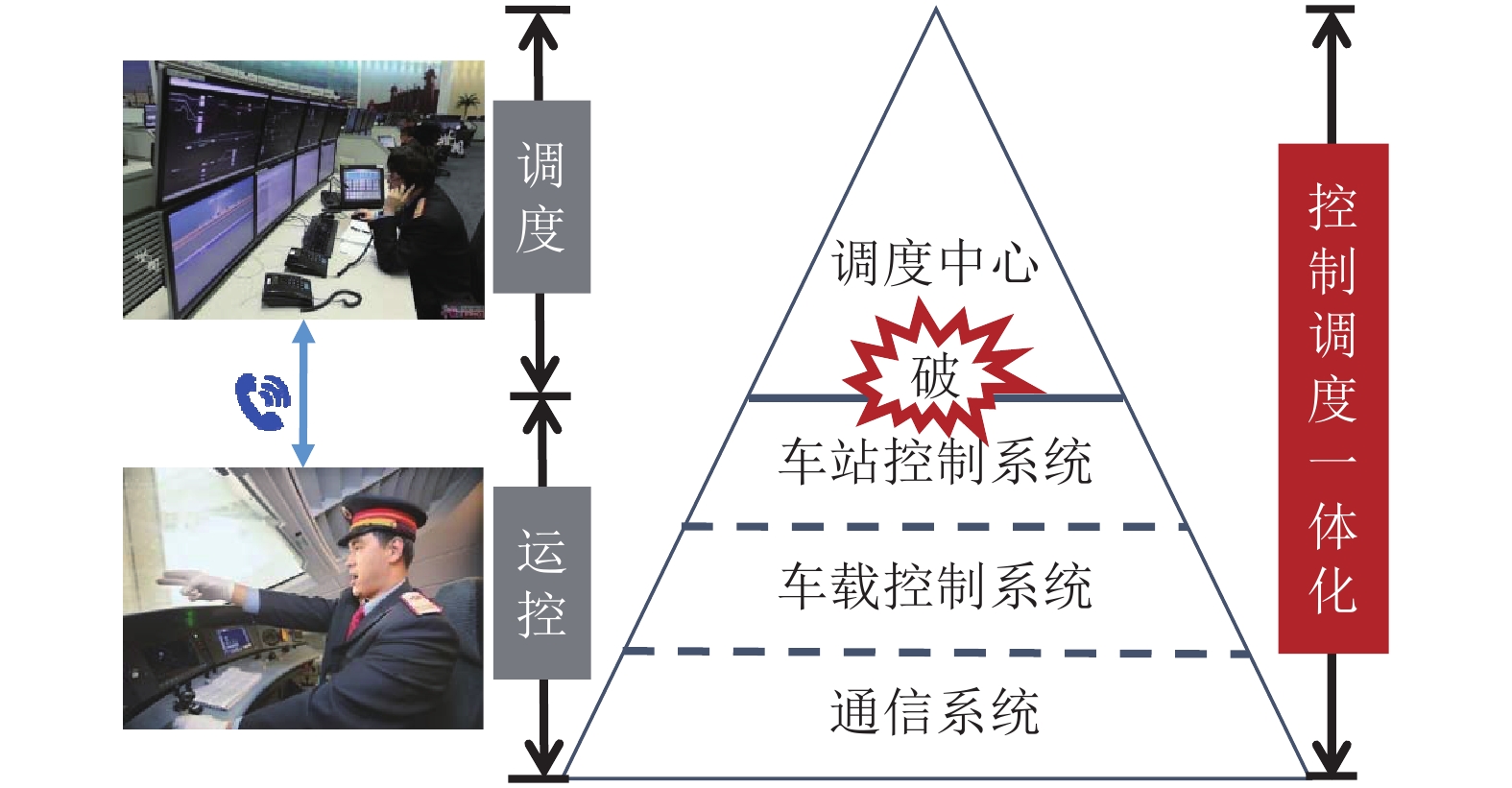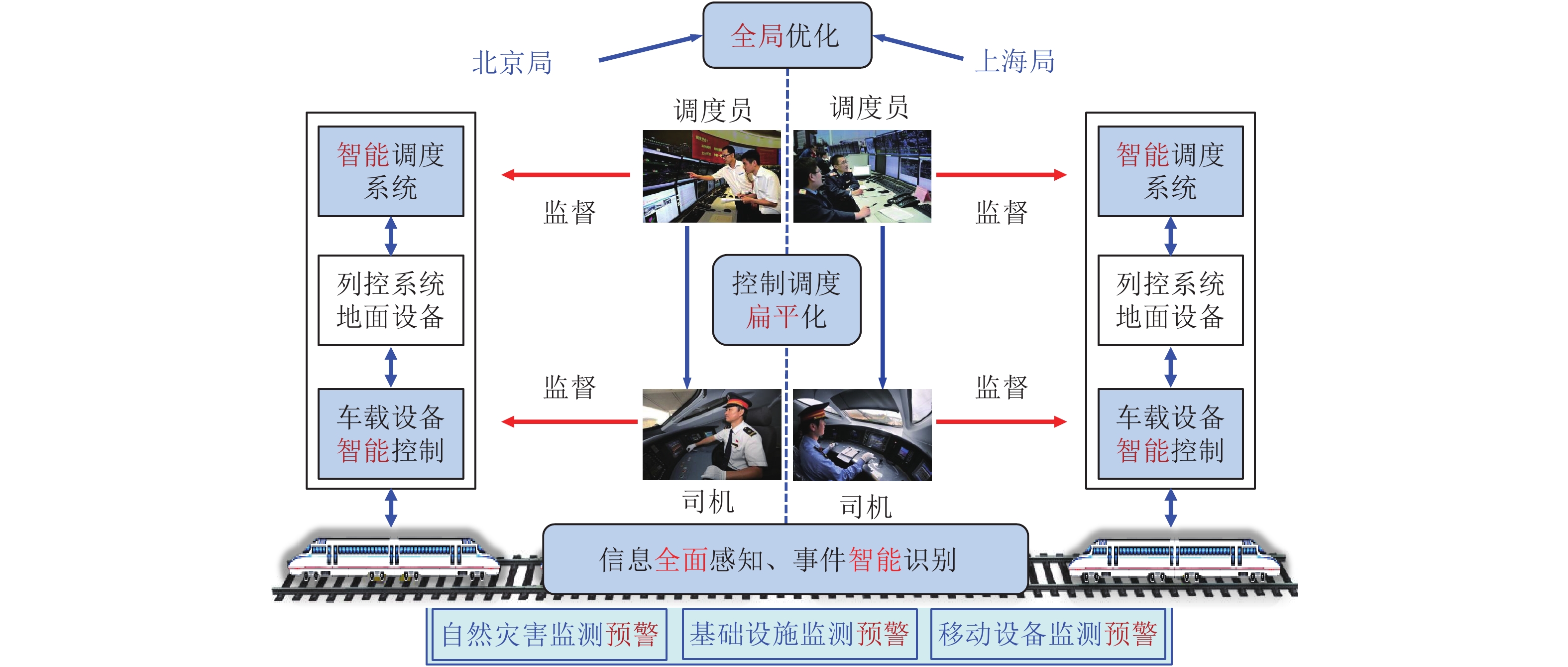|
[1]
|
宁滨, 唐涛, 李开成, 董海荣. 高速列车运行控制系统. 北京: 科学出版社, 2012.Ning Bin, Tang Tao, Li Kai-Cheng, Dong Hai-Rong. High-speed train operation control system. Beijing: Science Press, 2012.
|
|
[2]
|
何华武. 中国高速铁路创新与发展. 中国铁路, 2010, 12: 5−8 doi: 10.3969/j.issn.1001-683X.2010.12.0022 He Hua-Wu. Innovation and development of high-speed railway in China. Chinese Railways, 2010, 12: 5−8 doi: 10.3969/j.issn.1001-683X.2010.12.002
|
|
[3]
|
汪希时. 智能铁路运输系统ITS-R. 北京: 中国铁道出版社, 2004.Wang Xi-Shi. Intelligent Railway Transportation System ITS-R. Beijing: Science Press, 2004.
|
|
[4]
|
王同军. 智能铁路总体架构与发展展望. 铁路计算机应用, 2018, 27(7): 1−8 doi: 10.3969/j.issn.1005-8451.2018.07.0034 Wang Tong-Jun. Overall framework and development prospect of intelligent railway. Railway computer application, 2018, 27(7): 1−8 doi: 10.3969/j.issn.1005-8451.2018.07.003
|
|
[5]
|
刘朝英, 莫志松. 京津城际高速铁路信号系统集成. 北京: 中国铁道出版社, 2010.Liu Chao-Ying, Mo Zhi-Song. Beijing-tianjin Intercity High-speed Railway Signal System Integration. Beijing: Science Press, 2010.
|
|
[6]
|
铁路部电务段. CTCS-3级列控系统总体技术方案. 北京: 中国铁道出版社, 2008.Railway Electrical Section. Overall Technical Plan of CTCS-3 train Control System. Beijing: China Railway Press, 2008.
|
|
[7]
|
肖代宁, 刘红燕. 国外高速铁路列车运行控制系统. 铁道标准设计, 2008, 4: 128−130 doi: 10.3969/j.issn.1004-2954.2008.12.0417 Xiao Dai-Ning, Liu Hong-Yan. Foreign high-speed railway train operation control system. Railway Standard Design, 2008, 4: 128−130 doi: 10.3969/j.issn.1004-2954.2008.12.041
|
|
[8]
|
柴天佑. 自动化科学与技术发展方向, 自动化学报, 2018, 44(11): 1923−1930Chai Tian-You. Development directions of automation science and technology. Acta Automatica Sinica, 2018, 44(11): 1923−1930
|
|
[9]
|
9 Ning B, Tang T, Gao Z Y, Yan F, Wang F Y, Zeng D D. Intelligent railway systems in China. IEEE Intelligent Systems, 2006, 21(5): 80−83 doi: 10.1109/MIS.2006.99
|
|
[10]
|
周东华, 纪洪泉, 何潇. 高速列车信息控制系统的故障诊断技术. 自动化学报, 2018, 44(7): 1153−116410 Zhou Dong-Hua, Ji Hong-Quan, He Xiao. Fault diagnosis techniques for the information control system of high-speed trains. Acta Automatica Sinica, 2018, 44(7): 1153−1164
|
|
[11]
|
11 Yang C H, Yang C, Peng T, Yang X Y. A fault-injection strategy for traction drive control systems. IEEE Transactions on Industrial Electronics, 2017, 64(7): 5719−5727 doi: 10.1109/TIE.2017.2674610
|
|
[12]
|
唐涛, 黄良骥. 列车自动驾驶系统控制算法综述. 铁道学报, 2003, 25(2): 98−102 doi: 10.3321/j.issn:1001-8360.2003.02.02112 Tang Tao, Huang Liang-Ji. A survey of control algorithm for automatic train opetation. Journal of the China Railway Society, 2003, 25(2): 98−102 doi: 10.3321/j.issn:1001-8360.2003.02.021
|
|
[13]
|
辛斌, 陈杰, 彭志红. 智能优化控制: 概述与展望. 自动化学报, 2013, 39(11): 1831−184813 Xin Bin, Chen Jie, Peng Zhi-Hong. Intelligent optimized control: overview and prospect. Acta Automatica Sinica, 2013, 39(11): 1831−1848
|
|
[14]
|
14 Howlett. A new look at the rate of change of energy consumption with respect to journey time on an optimal train journey. Transportation Research Part B: Methodological, 2016, 94: 387−408 doi: 10.1016/j.trb.2016.10.004
|
|
[15]
|
15 Khmelnitsky E. On an optimal control problem of train operation. IEEE Transactions on Automatic Control, 200, 45(7): 1257−1266
|
|
[16]
|
16 Zhuan X, Xia X H. Optimal scheduling and control of heavy haul trains equipped with electronically controlled pneumatic braking systems. IEEE Transactions on Control Systems Technology, 2007, 15(6): 1159−1166 doi: 10.1109/TCST.2007.899721
|
|
[17]
|
17 Dong H R, Gao S G, Ning B. Cooperative control synthesis and stability analysis of multiple trains under moving signaling systems. IEEE Transactions on Intelligent Transportation Systems, 2016, 17(10): 2730−2738 doi: 10.1109/TITS.2016.2518649
|
|
[18]
|
18 Gao S G, Dong H R, Ning B. Cooperative prescribed performance tracking control for multiple high-speed trains in moving block signaling system. IEEE Transactions on Intelligent Transportation Systems, 2019, 20(7): 2740−2749 doi: 10.1109/TITS.2018.2877171
|
|
[19]
|
19 Shangguan W, Yan X H, Cai B G, Wang J. Multiobjective optimization for train speed trajectory in CTCS high-speed railway with hybrid evolutionary algorithm. IEEE Transactions on Intelligent Transportation Systems, 2015, 16(4): 2215−2225 doi: 10.1109/TITS.2015.2402160
|
|
[20]
|
20 Tuyttens D, Fei H Y, Mezmaz M, Jalwan J. Simulation-based genetic algorithm towards an energy-efficient railway traffic control. Mathematical Problems in Engineering, 2013, 2(27): 343−347
|
|
[21]
|
21 Chou M, Xia X, Kayser C. Modelling and model validation of heavy-haul trains equipped with electronically controlled pneumatic brake systems. Control Engineering Practice, 2007, 15(4): 501−509 doi: 10.1016/j.conengprac.2006.09.006
|
|
[22]
|
22 Song Q, Song Y D, Tang T, Ning B. Computationally inexpensive tracking control of high-speed trains with traction/braking saturation. IEEE Transactions on Intelligent Transportation Systems, 2011, 12(4): 1116−1125 doi: 10.1109/TITS.2011.2143409
|
|
[23]
|
23 Faieghi M, Jalali A. Robust adaptive cruise control of high speed trains. ISA Transactions, 2014, 53(2): 533−541 doi: 10.1016/j.isatra.2013.12.007
|
|
[24]
|
Bai W, Lin Z, Dong H, et al. Distributed cooperative cruise control of multiple high-speed trains under a state-dependent information transmission topology. IEEE Transactions on Intelligent Transportation Systems, 2019. DOI: 10.1109/TITS.2019.2893583
|
|
[25]
|
25 Mao Z H, Tao G, Jiang B, Yan X G. Adaptive actuator compensation of position tracking for high-speed trains with disturbances. IEEE Transactions on Vehicular Technology, 2018, 67(7): 5706−5717 doi: 10.1109/TVT.2018.2808360
|
|
[26]
|
26 Dong H R, Ning B, Cai B G, Hou Z S. Automatic train control system development and simulation for high-speed railways. IEEE Circuits and Systems Magazine, 2010, 10(2): 6−18 doi: 10.1109/MCAS.2010.936782
|
|
[27]
|
27 Dong H R, Zhu H N, Li Y D, Lv Y S, Gao S G, Zhang Q, Ning B. Parallel intelligent systems for integrated high-speed railway operation control and dynamic scheduling. IEEE Transactions on Cybernetics, 2018, 48(12): 3381−3389 doi: 10.1109/TCYB.2018.2852772
|
|
[28]
|
28 Gu Q, Tang T, Cao F, Karimi H R, Song Y D. Peak power demand and energy consumption reduction strategies for trains under moving block signalling system. Mathematical Problems in Engineering, 2013.
|
|
[29]
|
29 Yan X H, Cai B G, Ning B, Shanggan W. Online distributed cooperative model predictive control of energy-saving trajectory planning for multiple high-speed train movements. Transportation Research Part C: Emerging Technologies, 2016, 69: 60−78 doi: 10.1016/j.trc.2016.05.019
|
|
[30]
|
30 Zhou L, Tong L, Chen J, Tang J J. Joint optimization of high-speed train timetables and speed profiles: a unified modeling approach using space-time-speed grid networks. Transportation Research Part B: Methodological, 2017, 97(6): 157−181
|
|
[31]
|
31 Yang L X, Li K P, Gao Z Y, Li X. Optimizing trains movement on a railway network. Omega, 2012, 40(5): 619−633 doi: 10.1016/j.omega.2011.12.001
|
|
[32]
|
32 Carvajal-Carreo W, Cucala A, Fernández-Cardador A. Fuzzy train tracking algorithm for the energy efficient operation of CBTC equipped metro lines. Engineering Applications of Artificial Intelligence, 2016, 53: 19−31 doi: 10.1016/j.engappai.2016.03.011
|
|
[33]
|
33 Li S K, Yang L X, Gao Z Y. Adaptive coordinated control of multiple high-speed trains with input saturation. Nonlinear Dynamics, 2016, 83(4): 2157−2169 doi: 10.1007/s11071-015-2472-8
|
|
[34]
|
34 Li S K, Yang L X, Gao Z Y. Coordinated cruise control for high-speed train movements based on a multi-agent model. Transportation Research Part C: Emerging Technologies, 2015, 56: 281−292 doi: 10.1016/j.trc.2015.04.016
|
|
[35]
|
Baek J, Lee C. The simulation of train separation control algorithm by movement authority using beacon. In: Proceedings of the 4th International Conference on Fuzzy Systems and Knowledge Discovery, 2007.
|
|
[36]
|
36 Pan D, Zheng Y P. Dynamic control of high-speed train following operation. Promet-traffic and Transportation, 2014, 26(4): 291−297 doi: 10.7307/ptt.v26i4.1256
|
|
[37]
|
37 Takagi R. Synchronisation control of trains on the railway track controlled by the moving block signalling system. IET Electrical Systems in Transportation, 2012, 2(3): 130−138 doi: 10.1049/iet-est.2011.0053
|
|
[38]
|
Ding Y, Bai Y, Liu F, et al. Simulation algorithm for energy-efficient train control under moving block system. In: Proceedings of the 2009 World Congress on Computer Science and Information Engineering, 2009.
|
|
[39]
|
39 Zhao Y B, Ioannou P. Positive train control with dynamic headway based on an active communication system. IEEE Transactions on Intelligent Transportation Systems, 2015, 16(6): 3095−3103 doi: 10.1109/TITS.2015.2435515
|
|
[40]
|
40 Xun J, Yin Y, Liu R H, Liu F. Cooperative control of high-speed trains for headway regulation: a self-triggered model predictive control based approach. Transportation Research Part C, 2019, 102: 106−120 doi: 10.1016/j.trc.2019.02.023
|
|
[41]
|
41 Szpigel B. Optimal train scheduling on a single track railway operational research. Operations Research, 1972, 72: 343−352
|
|
[42]
|
赵鹏. 高速铁路运营组织. 北京: 中国铁道出版社, 2009.Zhao Peng. High Speed Railway Operation Organization. Beijing: Science Press, 2009.
|
|
[43]
|
43 Cordeau J, Toth P, Vigo D. A survey of optimization models for train. Transportation Science, 1998, 32(4): 380−404 doi: 10.1287/trsc.32.4.380
|
|
[44]
|
44 Hansen I. Railway network timetabling and dynamic traffic management. International Journal of Civil Engineering, 2010, 8(1): 19−32
|
|
[45]
|
45 Cacchiani V, Huisman D, Kidd M, Kroon L, Toth P, Veelenturf L, Wagenaar J. An overview of recovery models and algorithms for real-time railway rescheduling. Transportation Research Part B: Methodological, 2014, 63: 15−37 doi: 10.1016/j.trb.2014.01.009
|
|
[46]
|
46 Törnquist J, Persson J. N-tracked railway traffic re-scheduling during disturbances. Transportation Research Part B, 2007, 41(3): 342−362 doi: 10.1016/j.trb.2006.06.001
|
|
[47]
|
47 Törnquist J. Design of an effective algorithm for fast response to the rescheduling of railway traffic during disturbances. Transportation Research Part C, 2012, 20: 62−78 doi: 10.1016/j.trc.2010.12.004
|
|
[48]
|
48 Schöbel A. Integer programming approaches for solving the delay management problem. Algorithmic Methods for Railway Optimization, 4359, 4359: 145−170
|
|
[49]
|
49 Dollevoet T, Huisman D, Schmidt M, Schöbel A. Delay management with rerouting of passengers. Transportation Science, 2012, 46: 74−89 doi: 10.1287/trsc.1110.0375
|
|
[50]
|
50 Hou Z P, Dong H R, Gao S G, Nicholson G, Chen L, Roberts C. Energy-saving metro train timetable rescheduling model considering ATO profiles and dynamic passenger flow. IEEE Transactions on Intelligent Transportation Systems, 2019
|
|
[51]
|
51 Schlechte T, Borndorfer R, Erol B. Micro-macro transformation of railway networks. Journal of Rail Transport planning and Management, 2011, 1: 38−48 doi: 10.1016/j.jrtpm.2011.09.001
|
|
[52]
|
52 Corman F, D’Ariano A, Pranzo M. Effectiveness of dynamic reordering and rerouting of trains in a complicated and densely occupied station area. Transportation Planning and Technology, 2011, 34(4): 341−362 doi: 10.1080/03081060.2011.577152
|
|
[53]
|
53 D'Ariano A, Pacciarelli D, Pranzo M. A branch and bound algorithm for scheduling trains in a railway network. European Journal of Operational Research, 2007, 183(2): 643−657 doi: 10.1016/j.ejor.2006.10.034
|
|
[54]
|
54 Corman F, D'Ariano A, Pacciarelli D, Pranzo M. A tabu search algorithm for rerouting trains during rail operations. Transportation Research Part B: Methodological, 2010, 44(1): 175−192 doi: 10.1016/j.trb.2009.05.004
|
|
[55]
|
55 Meng L Y, Zhou X S. Simultaneous train rerouting and rescheduling on an N-track network: a model reformulation with network-based cumulative flow variables. Transportation Research Part B, 2014, 67: 208−234 doi: 10.1016/j.trb.2014.05.005
|
|
[56]
|
56 Mazzarello M, Ottaviani E. A traffic management system for real-time traffic optimisation in railways. Transportation Research Part B, 2007, 41: 246−274 doi: 10.1016/j.trb.2006.02.005
|
|
[57]
|
57 Luan X J, Wang Y H, De Schutter B, Meng L Y, Lodewijks G, Corman F. Integration of real-time traffic management and train control for rail networks − Part 1: Optimization problems and solution approaches. Transportation Research Part B: Methodological, 2018, 115: 41−71 doi: 10.1016/j.trb.2018.06.006
|
|
[58]
|
58 Luan X J, Wang Y H, De Schutter B, Meng L Y, Lodewijks G, Corman F. Integration of real-time traffic management and train control for rail networks − Part 2: Extensions towards energy-efficient train operations. Transportation Research Part B: Methodological, 2018, 115: 72−94 doi: 10.1016/j.trb.2018.06.011
|
|
[59]
|
59 Ghaemi N, Zilko A A, Yan F, Cats O, Kurowick D, Goverde R M P. Impact of railway disruption predictions and rescheduling on passenger deeays. Journal of Rail Transport Planning and Management, 2018, 8(2): 103−122
|
|
[60]
|
60 Jespersen-Groth J, Potthoff D, Clausen J, Huisman D, Kroon L, Maróti G, Nielsen M N. Disruption management in passenger railway transportation. Robust and Qnline Large-scale Optimization, 2009: 399−421 doi: 10.1016/j.trc.2010.12.004
|
|
[61]
|
Ghaemi N, Goverde R M P. Review of railway disruption management practice and Literature. In: Proceedings of the 6th International Conference on Railway Operations Modelling and Analysis, Narashimo, Japan: Rail Tokyo, 2015. 037-1−037-16
|
|
[62]
|
62 Louwerse I, Huisman D. Adjusting a railway timetable in case of partial or complete blockades. European Journal of Operational Research, 2014, 235(3): 583−593 doi: 10.1016/j.ejor.2013.12.020
|
|
[63]
|
63 Acuna-Agost R, Michelon P, Feillet D, Gueye S. SAPI: Statistical analysis of propagation of incidents. A new approach for rescheduling trains after disruptions. European Journal of Operational Research, 2011, 215(1): 227−243 doi: 10.1016/j.ejor.2011.05.047
|
|
[64]
|
64 Zhan S G, Kroon L G, Veelenturf L P, Wagenaar J C. Real-time high-speed train rescheduling in case of a complete blockage. Transportation Research Part B: Methodological, 2015, 78: 182−201 doi: 10.1016/j.trb.2015.04.001
|
|
[65]
|
65 Zhu Y Q, Rob M. Goverde R M P. Railway timetable rescheduling with flexible stopping and flexible short-turning during disruptions. Transportation Research Part B: Methodological, 2019, 123(1): 149−181
|
|
[66]
|
66 Xu P J, Corman F, Peng Q Y, Luan X J. A train rescheduling model integrating speed management during disruptions of high-speed traffic under a quasi-moving block system. Transportation Research Part B: Methodological, 2017, 104: 638−666 doi: 10.1016/j.trb.2017.05.008
|





 下载:
下载:



